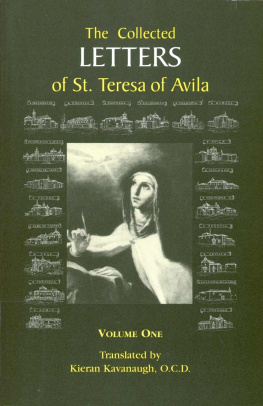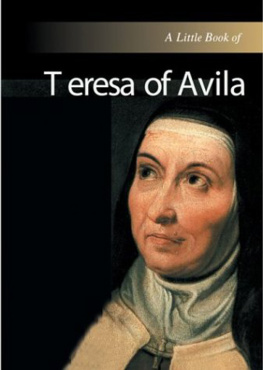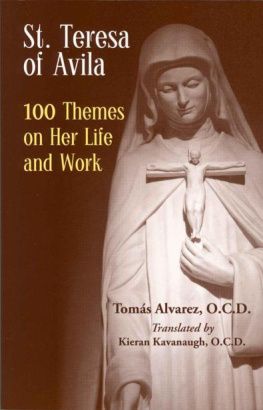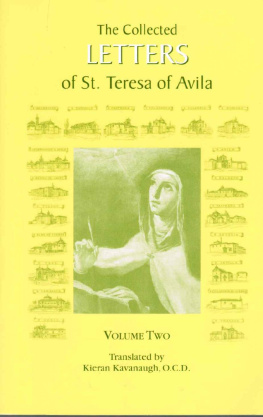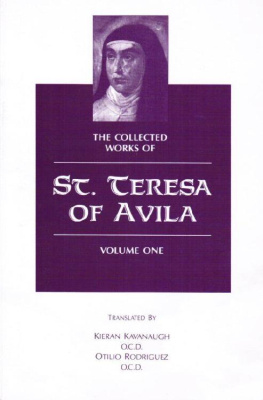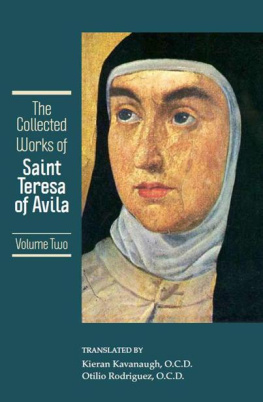The Collected
Letters
of St. Teresa
of Avila
Volume One
Translated by
Kierran Kavanaugh, O.C.D.
Washington Province of Discalced Carmelites, Inc. 2001
ICS Publications
2131 Lincoln Road NE
Washington, D.C. 20002-1199
800-832-8489
www.icspublications.org
Library of Congress Cataloguing in Publication Data
Teresa, of Avila, Saint, 1515-1582
[Correspondence, English]
The collected letters of St. Teresa of Avila / translated by Kieran Kavanaugh.
p.cm..
Includes biblographical references and index.
ISBN 0-935216-27-8
1. Teresa, of Avila, Saint, 1515-1582 -- Correspondence.
2. Christian saints -- Spain -- Avila -- Correspondence.
1. Kavanaugh, Kieran, 1928- II. Title.
BX4700.T4 A31 2001
282'.092--dc21
[B]
Table of Contents
Abbreviations
References to St. Teresa's other writings are from The Collected Works of St. Teresa of Avila , trans. Kieran Kavanaugh, O.C.D., and Otilio Rodriguez, O.C.D., 3 vols. (Washington, D.C.: ICS Publications, 1976-85). The following abbreviations will be used in referring to her works:
| F | The Book of Her Foundations (vol. 3) |
| IC | The Interior Castle (vol. 2) |
| L | The Book of Her Life (vol. 1) |
| M | Meditations on the Song of Songs (vol. 2) |
| SC | A Satirical Critique (vol. 3) |
| ST | Spiritual Testimonies (vol. 1) |
| W | The Way of Perfection (vol. 2) |
Other abbreviations:
| BMC | Biblioteca Mistica Carmelitana, ed., Silverio de Santa Teresa, 20 vols (Burgos: El Monte Carmelo, 1915-35) |
| BN | Biblioteca Nacional , Madrid |
| CN | Carmelite Nuns of the Observance |
| DCF | Discalced Carmelite Friars |
| DCN | Discalced Carmelite Nuns |
| MHCT | Monumenta Historica Carmeli Teresiani, Insitutum Historicum Teresianum (Rome: Teresianum, 1973-) |
Introduction
St. Teresa's correspondence makes up nearly one half of her known writings. Her letters have left us with a treasure-trove of vivid narratives about her times, along with illuminating insights into her personality. Only those letters written by Teresa in the last couple decades of her life have reached us, however, those decades representing the same period in which she wrote her major works. It is not difficult to admit that her career as a spiritual author flowed from her mystical experience of God. But while spiritual needs prompted Teresa's classic works, it was the many other needs of her daily life that drove her to letter-writing. Her letters, as a rule, do not give us the kind of teaching and testimony we have grown accustomed to in her other works. Rather, they show us a different facet of Teresa, a Teresa immersed in the relationships and grim business matters thrust upon her by her vocation as a foundress and reformer.
Certainly she had written honestly and openly the story of her life and work in her two books, The Life and The Foundations . Despite the openness of these works, however, she wrote in the knowledge they would be read by her confessors and eventual censors. Her letters exhibit an even greater candor, and we benefit from many more details that were not meant for the public, nor even for her confessors or censors. Even at that, many personal details in her Life were not meant for broadcast. A keen observer of the reality around her as well as within, Teresa focuses light on many of the struggles in both the Carmelite order and the church of sixteenth-century Spain. She introduces us to major personalities who have left their mark on history.
In addition, historians benefit from the letters because many of the gaps in the outline of events that is presented in her Foundations are filled in through her letters. Through them we also gain better knowledge of the chronology of events in her life and of how she related to the diverse people she dealt with. A number of everyday particulars that compilers and editors of those times considered unimportant are today prized. Her worries, her troubles and triumphs, her expressions of sadness and joy, can all be discerned there. With a compelling spontaneity, the letters disclose a Teresa in a complex variety of circumstances. We walk with her year by year, day by day -- even hour by hour sometimes. Without question we have before us a rich collection of documents, unbroken in their sequence, revealing in confidential tones a personal history that touches the furthest reaches of her soul.
Despite the fact that the letter-writing was a necessity, any reader can easily see that, though a lover of solitude and prayer, Teresa possessed a heart magnanimously open to others. Ever willing to communicate with them on many levels different from the decidedly spiritual level mainly found in her other writings, she pours herself out to her family members, her religious sisters and brothers, to friends, theologians, advisors, patrons of the nobility, and business people. She had to travel and buy and sell. The ever-present burden of fund-raising wearied her. Problems sprang up over jurisdiction, stirring her to write to Rome and even to King . She had to chose prioresses, advise and comfort them, and discuss the nettlesome pros and cons ever present in the selection of new postulants, as well as doubts about dowries and other material needs. People's health was always a disquieting concern for her.
A Daily Torment
The extraordinary gifts of grace bestowed by God on this Spanish Madre fortified her for a demanding ministry of service which entailed heavy responsibilities that drew her contemplative soul into a maelstrom of activities. Because of the limited means for travel and communication in the sixteenth century, the organization of a reform like hers, with its unavoidable business matters, had to be dealt with chiefly through correspondence, a chafing duty that became one of Teresa's greatest trials. She wrote, "With so many duties and troubles ... I wonder how I'm able to bear them all. The biggest burden is letter-writing" (). This is the often repeated confession of a woman overwhelmed with worries. Difficult as writing a book was for her, she preferred it to the letter-writing, a drudgery that cost her more than all the pitiful roads and sorry weather experienced on her journeys through Spain.
What proved painful for Teresa has proved a treasure for us, a collection claimed by scholars to be unparalleled in Spanish literature even to this day. With their humor and delicacy, the letters on the surface do not betray the inner self-coercion they hide. Held bondage by her correspondence, Teresa worked at it day after day, often far into the night by the light of a poor little oil lamp. The pile of letters to be answered was enough to drive her mad. Yet, even though she could be busy answering them until two in the morning, she was up with the rest of the community at five in summer, and six in winter.
Eventually the burden and the lack of sleep took its toll, and she fell into the alarming exhaustion of 1577, precisely in the most intense period of her correspondence. "But I wrote you yesterday, and the labor of letter-writing this winter has so weakened my head that I have been truly sick" ().
The use of a secretary became more common after the exhaustion of 1577. "You should know, mi padre , that my heavy correspondence and many other duties that I tried to handle all alone have caused a noise and weakness in my head. And I have been given orders that unless it's very necessary I should not be writing letters in my own hand" (). Sometimes Teresa begins the letter herself, gives it to the secretary to continue, and then adds some final words in her own hand. If she needed a special guarantee because of the uncertainty that surrounded the mail, she again turned for help to a secretary to make copies. She would order duplicates, triplicates, and even quadruplicates to be made and sent by different means. In that way she could sustain some hope that at least one would reach its destination.

